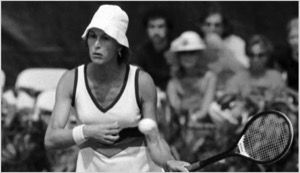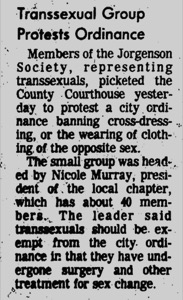
How many remember way back in 1966 when renowned crossdresser Virginia Prince met with San Diego Police to argue against the city adopting an ordinance used to harass transgender people?
Or when Nicole Murray Ramirez founded the Christine Jorgensen Society in 1974 and organized transsexuals to picket the San Diego County Courthouse? And do you recall the national attention San Diego received when Dr. Renee Richards was outed as a transsexual in 1976 during a tennis tournament in La Jolla?
These events are examples of San Diego’s transgender history, and they are now part of the city’s LGBT Historic Context Statement. This statement will be used to decide which buildings should be preserved because of their historical significance for our LGBT community.
This statement also contains a historical overview of San Diego’s LGBT community, covering topics such as political activism, organizations, arts and culture. The original 106-page document totally ignored the contributions of our trans community and excluded references to LGBT people of color. We trans folk were, once again, subsumed under the gay and lesbian banner.
Aug. 25, the city held a workshop to solicit feedback from the community. I offered two pages of references documenting our history, citing local transgender people, organizations, events and important structures. And Chuck Kaminski of Lambda Archives presented nine pages of recommendations documenting the diversity of our community; recommendations that included contributions by LGBT people of color.

City representatives were completely caught off guard by the criticism and our insistence that they include the additional information we gave them. City planners argued that there was no time and no more money to incorporate our suggestions into the document. Their Sept. 30 deadline for submission to the state was fast approaching.
Over the next few weeks, Kaminski and I applied all the pressure we could. I contacted GPA Consulting, the Los Angeles company that wrote the statement, and Councilman Todd Gloria’s office. Kaminski reached out to The California Office of Historic Preservation, which funded the grant to pay for the document, and to San Diego Mayor Kevin Faulconer. Somehow the city found the time and money to incorporate the changes we requested. Thank you City of San Diego for finally listening to our community.
But this entire process did not need to be so contentious. I believe some of the stumbling blocks include: The city hiring a Los Angeles company to write a historic statement about San Diego; the city taking more than 11 months and three drafts before inviting public comment and then insisting that there was no time to make significant changes; and city representatives calling the context statement a “living document” to persuade us that at some point in the future they could revise the document.
Kaminski, myself and others at the public workshop didn’t buy it. Once you’re left out, you just become an afterthought. Trans folk and LGBT people of color must be included from the beginning.
As a historian who was personally involved in preparing similar historic statements, I can tell you that these are not living documents. This historic statement will never be updated and what is there from the beginning is what will be used by historians sometime in the distant future to analyze and write about our LGBT community.

In the final LGBT Historic Context Statement, the city acknowledged our objections, writing: “the staff received comments that bisexual, transgender and queer communities, as well as LGBTQ people of color were not as fully represented in the context as the lesbian and gay communities.” And they defended themselves against our criticism by arguing that “this was due in part to limited availability of archival information.”
But that’s not correct. The archival material on local transgender history is available. You just have to make the effort to incorporate marginalized groups of people into the story.
Since I’ve been researching our history, I found some of the following examples: Doctors at UCSD Medical Center performed gender confirmation surgeries from the late 1970s through the early 1980s; trans icon and Stonewall Riot participant Miss Major Griffin-Gracy worked as an activist in San Diego for 10 years during the 1970s and 1980s; local transgender organizations such as Neutral Corner, Phoenix Rising and Trans Action played important roles in improving the lives of trans people.
We trans folk in San Diego can take pride in our history. We will not sit still when the LGBT narrative fails to include us.











